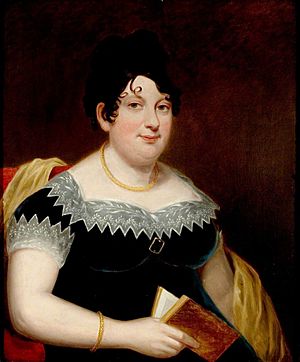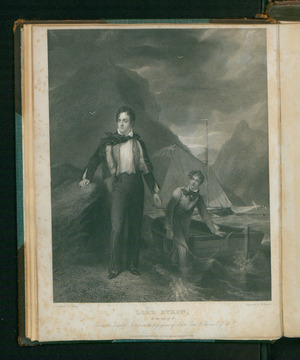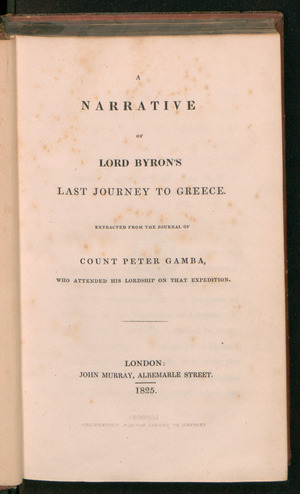Lord Byron facts for kids
Quick facts for kids
The Lord Byron
|
|
|---|---|
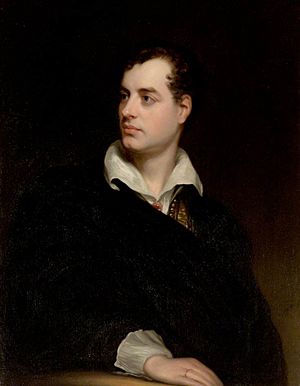
Portrait of Byron by Thomas Phillips, c. 1813
|
|
| Born | George Gordon Byron 22 January 1788 London, England |
| Died | 19 April 1824 (aged 36) Missolonghi, Aetolia, Ottoman Empire (present-day Aetolia-Acarnania, Greece) |
| Resting place | Church of St. Mary Magdalene, Hucknall, Nottinghamshire |
| Occupation | Poet, politician |
| Nationality | English |
| Education | Harrow (1801–1805) |
| Alma mater | Trinity College, Cambridge (1805–1808) |
| Literary movement | Romanticism |
| Notable works |
|
| Spouse |
Anne Isabella Milbanke
(m. 1815; separated 1816) |
| Partner | Claire Clairmont |
| Children |
|
| Relatives | Capt. John "Mad Jack" Byron (father) Catherine Gordon (mother) Vice-Admiral The Hon. John Byron (grandfather) |
|
|
|
| Signature |  |
George Gordon Byron, 6th Baron Byron (22 January 1788 – 19 April 1824) was an English peer, nobleman, politician, and poet. He was christened George Gordon Byron, but changed his name later in life. He adopted the surname Noel, so he that could inherit half his mother-in-law's estate.
Lord Byron was the son of Captain John Byron and Catherine Gordon.
He was a leading figure in Romanticism. He was regarded as one of the greatest European poets and still many people read his works. Among his best-known works are the narrative poems Childe Harold's Pilgrimage and Don Juan.
Lord Byron is also famous for the way he lived his life. His fight against the Turks in the Greek War of Independence lead to his death from a fever in Messolonghi in Greece. He is buried in the family vault in St. Mary Magdalene Church, Hucknall Torkard, Nottinghamshire, England. A memorial was not raised to him in Poet's Cornerin Westminster Abbey until 1969.
His daughter, Ada Lovelace, was famous because she collaborated with Charles Babbage on the "analytical engine", a predecessor to modern computers.
Contents
Early life and education

George Gordon Byron was born on 22 January 1788, on Holles Street in London, England. He was the only child of Captain John Byron (known as 'Jack') and his second wife Catherine Gordon, heiress of the Gight estate in Aberdeenshire, Scotland. His father died of tuberculosis in 1791.
In 1801, Byron was sent to Harrow School, where he remained until July 1805. An undistinguished student and an unskilled cricketer, he nevertheless represented the school during the very first Eton v Harrow cricket match at Lord's in 1805. He continued his education at Trinity College, Cambridge.
Adult life and literary career
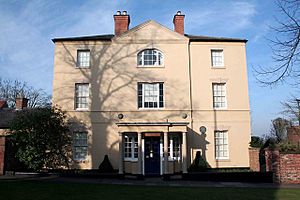
While not at school or college, Byron lived at his mother's residence, Burgage Manor in Southwell, Nottinghamshire. While there, he wrote his first volumes of poetry.
His poem Childe Harold's Pilgrimage, published in 1812, was received with critical acclaim. In Byron's own words, "I awoke one morning and found myself famous." He followed up this success with four equally celebrated "Oriental Tales": The Giaour, The Bride of Abydos, The Corsair, and Lara. His other works during this period include Parisina and The Siege of Corinth (1815).
Lord Byron travelled extensively across Europe to places such as Italy, where he lived for seven years in Venice, Ravenna, and Pisa. During his stay in Italy, he frequently visited his friend and fellow poet Percy Bysshe Shelley. Later in life Byron joined the Greek War of Independence fighting the Ottoman Empire and died leading a campaign during that war, for which Greeks revere him as a folk hero.
Death
He died in 1824 at the age of 36 from a fever contracted after the first and second sieges of Missolonghi.
Byron's body was embalmed, but the Greeks wanted some part of their hero to stay with them. According to some sources, his heart remained at Missolonghi. His other remains were sent to England. Huge crowds viewed his coffin as he lay in state for two days at number 25 Great George Street, Westminster. He is buried at the Church of St. Mary Magdalene in Hucknall, Nottinghamshire. A marble slab given by the King of Greece is laid directly above Byron's grave. His daughter Ada Lovelace was later buried beside him.
Byron's friends raised £1,000 to commission a statue of the writer; Thorvaldsen offered to sculpt it for that amount. However, after the statue was completed in 1834, for ten years, British institutions turned it down and it remained in storage. It was refused by the British Museum, St. Paul's Cathedral, Westminster Abbey and the National Gallery before Trinity College, Cambridge finally placed the statue of Byron in its library.
Personal life
Children
Byron had a child, The Hon. Augusta Ada Byron ("Ada", later Countess of Lovelace), in 1815, by his wife Annabella Byron, Lady Byron (née Anne Isabella Milbanke, or "Annabella"), later Lady Wentworth. Ada Lovelace, notable in her own right, collaborated with Charles Babbage on the analytical engine, a predecessor to modern computers. She is recognised as one of the world's first computer programmers.
Byron also fathered a daughter, Clara Allegra Byron, with Claire Clairmont, stepsister of Mary Shelley and stepdaughter of William Godwin, writer of Political Justice and Caleb Williams.
His third daughter, Elizabeth Medora Leigh, was born in 1814. Her mother was Augusta Leigh.
-
Ada Lovelace
(1815–1852)
Scotland
Byron had a complex identity and strong ties to Scotland. In terms of his own identity, he described himself as "half a Scot by birth, and bred/A whole one" and he reportedly spoke with a faint Scottish accent throughout his life.
Sea and swimming
Byron enjoyed adventure, especially relating to the sea.
The first recorded notable example of open water swimming took place on 3 May 1810 when Lord Byron swam from Europe to Asia across the Hellespont Strait. This is often seen as the birth of the sport and pastime, and to commemorate it, the event is recreated every year as an open water swimming event.
Fondness for animals
Byron had a great love of animals, most notably for a Newfoundland dog named Boatswain. When the animal contracted rabies, Byron nursed him, albeit unsuccessfully, without any thought or fear of becoming bitten and infected.
Although deeply in debt at the time, Byron commissioned an impressive marble funerary monument for Boatswain at Newstead Abbey, larger than his own, and the only building work that he ever carried out on his estate. In his 1811 will, Byron requested that he be buried with him. The 26‐line poem "Epitaph to a Dog" has become one of his best-known works. But a draft of an 1830 letter by Hobhouse shows him to be the author; Byron decided to use Hobhouse's lengthy epitaph instead of his own, which read: "To mark a friend's remains these stones arise/I never knew but one – and here he lies."
Byron also kept a tame bear while he was a student at Trinity out of resentment for rules forbidding pet dogs like his beloved Boatswain. There being no mention of bears in their statutes, the college authorities had no legal basis for complaining; Byron even suggested that he would apply for a college fellowship for the bear.
During his lifetime, in addition to numerous cats, dogs, and horses, Byron kept a fox, monkeys, an eagle, a crow, a falcon, peacocks, guinea hens, an Egyptian crane, a badger, geese, a heron, and a goat. Except for the horses, they all resided indoors at his homes in England, Switzerland, Italy, and Greece.
Health and appearance
Deformed foot
From birth, Byron had a deformity of his right foot. Although it has generally been referred to as a "club foot", some modern medical authors maintain that it was a consequence of infantile paralysis (poliomyelitis), and others that it was a dysplasia, a failure of the bones to form properly. Whatever the cause, he was affected by a limp that caused him lifelong psychological and physical misery, aggravated by painful and pointless "medical treatment" in his childhood and the nagging suspicion that with proper care it might have been cured.
He was extremely self-conscious about this from a young age, nicknaming himself le diable boîteux (French for "the limping devil"). Although he often wore specially-made shoes in an attempt to hide the deformed foot, he refused to wear any type of brace that might improve the limp.
Physical appearance
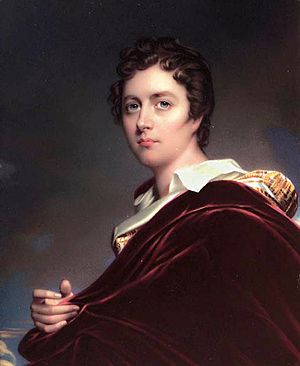
Byron's adult height was 5 feet 9 inches (1.75 m), his weight fluctuating between 9.5 stone (133 lb; 60 kg) and 14 stone (200 lb; 89 kg). He was renowned for his personal beauty, which he enhanced by wearing curl-papers in his hair at night. He was athletic, being a competent boxer and horse-rider and an excellent swimmer. He attended pugilistic tuition at the Bond Street rooms of former prizefighting champion 'Gentleman' John Jackson, whom Byron called 'the Emperor of Pugilism', and recorded these sparring sessions in his letters and journals.
Byron and other writers, such as his friend Hobhouse, described his eating habits in detail. At the time he entered Cambridge, he went on a strict diet to control his weight. He also exercised a great deal, and at that time wore a great many clothes to cause himself to perspire. For most of his life, he was a vegetarian and often lived for days on dry biscuits and white wine.
Trelawny, who observed Byron's eating habits, noted that he lived on a diet of biscuits and soda water for days at a time and then would eat a "horrid mess of cold potatoes, rice, fish, or greens, deluged in vinegar, and gobble it up like a famished dog".
Political career
Byron first took his seat in the House of Lords on 13 March 1809 but left London on 11 June 1809 for the Continent. A strong advocate of social reform, he received particular praise as one of the few Parliamentary defenders of the Luddites: specifically, he was against a death penalty for Luddite "frame breakers" in Nottinghamshire, who destroyed textile machines that were putting them out of work.
Byron expressed opposition to the established religion because it was unfair to people of other faiths.
These experiences inspired Byron to write political poems such as Song for the Luddites (1816) and The Landlords' Interest, Canto XIV of The Age of Bronze. Examples of poems in which he attacked his political opponents include Wellington: The Best of the Cut-Throats (1819) and The Intellectual Eunuch Castlereagh (1818).
Poetic works
Byron wrote prolifically. In 1832 his publisher, John Murray, released the complete works in 14 duodecimo volumes, including a life by Thomas Moore. Subsequent editions were released in 17 volumes, first published a year later, in 1833. An extensive collection of his works, including early editions and annotated manuscripts, is held within the John Murray Archive at the National Library of Scotland in Edinburgh.
Byronic hero
The figure of the Byronic hero pervades much of his work, and Byron himself is considered to epitomise many of the characteristics of this literary figure. The use of a Byronic hero by many authors and artists of the Romantic movement show Byron's influence during the 19th century and beyond, including the Brontë sisters.
The Byronic hero presents an idealised, but flawed character whose attributes include: great talent; great passion; a distaste for society and social institutions; a lack of respect for rank and privilege (although possessing both); being thwarted in love by social constraint or death; rebellion; exile; an unsavoury secret past; arrogance; overconfidence or lack of foresight; and, ultimately, a self-destructive manner. These types of characters have since become ubiquitous in literature and politics.
Legacy and commemoration
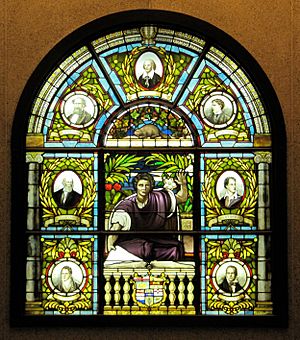
Βύρων, the Greek form of "Byron", continues in popularity as a masculine name in Greece, and a suburb of Athens is called Vyronas in his honour.
In 1969, 145 years after Byron's death, a memorial to him was finally placed in Westminster Abbey.
Close to the centre of Athens, Greece, outside the National Garden, is a statue depicting Greece in the form of a woman crowning Byron. The statue is by the French sculptors Henri-Michel Chapu and Alexandre Falguière. As of 2008[update], the anniversary of Byron's death, 19 April, has been honoured in Greece as "Byron Day".
Byron exercised a marked influence on Continental literature and art, and his reputation as a poet is higher in many European countries than in Britain, or America, although not as high as in his time, when he was widely thought to be the greatest poet in the world. Byron's writings also inspired many composers. Over forty operas have been based on his works, in addition to three operas about Byron himself (including Virgil Thomson's Lord Byron). His poetry was set to music by many Romantic composers, including Beethoven, Schubert, Rossini, Mendelssohn, Schumann and Carl Loewe. Among his greatest admirers was Hector Berlioz, whose operas and Mémoires reveal Byron's influence. In the twentieth century, Arnold Schoenberg set Byron's "Ode to Napoleon" to music.
In April 2020, Byron was featured in a series of UK postage stamps issued by the Royal Mail to commemorate the Romantic poets on the 250th anniversary of the birth of William Wordsworth. Ten 1st class stamps were issued of all the major British romantic poets, and each stamp included an extract from one of their most popular and enduring works, with Byron's "She Walks in Beauty" selected for the poet.
Works
- Hours of Idleness (1806)
- English Bards and Scotch Reviewers (1809)
- Childe Harold's Pilgrimage (1812–1818)
- The Giaour (1813)
- The Bride of Abydos (1813)
- The Corsair (1814)
- Lara (1814)
- Hebrew Melodies (1815)
- The Siege of Corinth (poem) (1816)
- Parisina (1816)
- The Prisoner Of Chillon (1816)
- The Dream (1816)
- Prometheus (1816)
- Darkness (1816)
- Manfred (1817)
- The Lament of Tasso (1817)
- Beppo (1818)
- Mazeppa (1819)
- The Prophecy of Dante (1819)
- Marino Faliero (1820)
- Sardanapalus (1821)
- The Two Foscari (1821)
- Cain (1821)
- The Vision of Judgement (1821)
- Heaven and Earth (1821)
- Werner (1822)
- The Deformed Transformed (1822)
- The Age of Bronze (1823)
- The Island (1823)
- Don Juan (1819–1824; incomplete on Byron's death in 1824)
- So, we'll go no more a roving
- The First Kiss of Love (1806)
- Thoughts Suggested by a College Examination (1806)
- To a Beautiful Quaker (1807)
- The Cornelian (1807)
- Lines Addressed to a Young Lady (1807)
- Lachin y Garr (1807)
- Epitaph to a Dog (1808) (
- She Walks in Beauty (1814)
- When We Two Parted
Images for kids
-
Byron's visit to San Lazzaro as depicted by Ivan Aivazovsky (1899)
-
"Byron's Grotto" in Porto Venere, Italy, named in his honour, because according to a local legend he meditated here and drew inspiration from this place for his literary works
-
Statue of Lord Byron in Athens
-
Lord Byron in Albanian dress by Thomas Phillips, 1813. Venizelos Mansion, Athens (the British Ambassador's residence).
-
The reception of Lord Byron at Missolonghi
See also
 In Spanish: Lord Byron para niños
In Spanish: Lord Byron para niños


